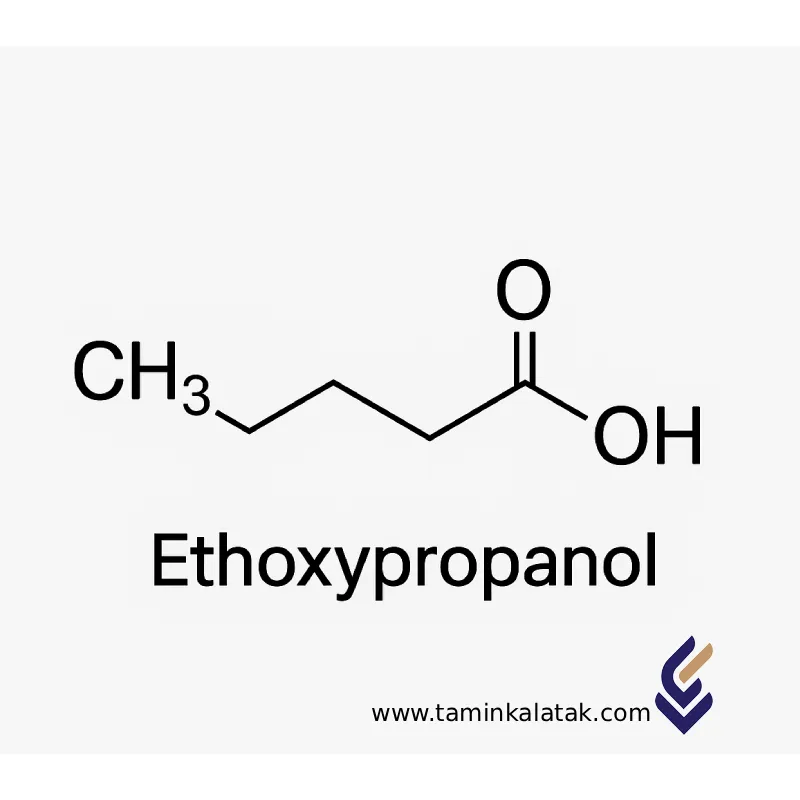Ethoxypropanol
Ethoxypropanol (1-Ethoxy-2-propanol) is a clear, colorless solvent with a mild ether-like odor. Owing to the presence of both polar (–OH) and non-polar (–O–CH₂CH₃) functional groups, this compound belongs to the class of mono-functional glycol ethers.
It is widely used in paint, coating, printing, detergent, resin, and cosmetic formulations as an effective solvent with controlled evaporation rate and excellent solubility characteristics.
Chemical Structure of Ethoxypropanol
-
Molecular formula: C₅H₁₂O₂
-
Structural formula: CH₃–CH(OCH₂CH₃)–CH₂–OH
-
IUPAC name: 1-Ethoxy-2-propanol
-
Chemical type: Mono-functional glycol ether containing both a hydroxyl group (–OH) and an ethoxy branch (–O–CH₂CH₃), suitable for dissolving both polar and non-polar compounds
Physical and Chemical Properties
| Property | Description |
|---|---|
| Appearance | Colorless to very pale yellow liquid with an ether-like odor |
| Boiling point | ~132 °C |
| Refractive index | 1.4065–1.407 |
| Flash point | 38.5–42 °C (closed cup) |
Applications of Ethoxypropanol
1. Paint and Resin Industry
-
Used as a medium-evaporation solvent in water-based and solvent-based paints and coatings
-
Improves flow, leveling, and surface gloss of coatings
-
Reduces surface tension, enhancing adhesion of paints to various substrates
2. Printing and Ink Industry
-
Serves as a pigment carrier and solvent in inkjet, screen, flexographic, and gravure inks
-
Controls drying speed and prevents nozzle clogging, especially in thermal inkjet printers
-
Enhances print sharpness and prevents pigment sedimentation
3. Detergents and Industrial Cleaners
-
Used as a solvent for degreasing metal, glass, and plastic surfaces
-
Ideal for semi-volatile, non-corrosive cleaners due to its mild odor and relatively low toxicity
-
An effective, environmentally friendly alternative to heavier glycol ethers
4. Cosmetics and Personal Care (Limited, Regulated Use)
-
Acts as a carrier or co-solvent for aromatic or active ingredients in certain skin and hair formulations
-
Usage is restricted due to potential skin irritation at high concentrations
-
Must comply with IFRA and REACH regulatory standards
5. Agricultural and Pesticide Formulations
-
Enhances dispersion and solubility of active ingredients in spray formulations
-
Improves foliar absorption and reduces surface tension in liquid fertilizer and pesticide systems
Advantages of Ethoxypropanol
-
Dual solubility: Efficiently dissolves both polar and non-polar compounds
-
Moderate evaporation rate: Allows controlled drying in coating and ink applications
-
Excellent compatibility with both water and organic solvents
-
Chemical and physical stability in complex formulations
-
Surface tension reduction and improved lubricity in chemical systems
Limitations and Disadvantages
-
Flammable – requires proper ventilation and storage away from heat sources
-
Irritating to skin and eyes upon direct contact
-
Vapor inhalation at high concentrations may cause respiratory or neurological effects – must comply with OSHA exposure limits
-
Requires high-purity grades for cosmetic or pharmaceutical applications
Safety and Storage Guidelines
From a safety perspective, Ethoxypropanol should be handled and stored with care, as its vapors can irritate the eyes, skin, and respiratory system. Prolonged skin exposure may lead to dryness or inflammation.
Precautions and Storage Conditions
-
Store in a cool, dry, and well-ventilated area.
-
Keep away from open flames and ignition sources (highly flammable).
-
Use chemical-resistant gloves, safety goggles, and a respirator when handling.
-
Containers should be tightly closed, solvent-resistant, and clearly labeled to prevent vapor leakage and evaporation.
Applications
| Applications | , , , , , , |
|---|
Ethoxypropanol
| Products | Chemical formula | CAS number | Grade | Solubility in water | Vapor pressure | Melting point | Density (at 20°C) | Physical appearance |
|---|---|---|---|---|---|---|---|---|
| 1‑Ethoxy‑2‑propanol | C₅H₁₂O₂ | 1569‑02‑4 | Industrial Grade and Laboratory Grade (Purity ≥95%) | Fully miscible with water (~36.6 g/100 mL @ 25 °C) | ~30 Pa (~0.23 mmHg) or 4 kPa some sources | About −90 °C to −100 °C | ~0.896–0.903 g/mL | Clear, colorless to very pale yellow liquid; mild ether-like odor |







